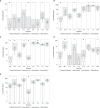Stimulated Immune Response by TruCulture® Whole Blood Assay in Patients With European Lyme Neuroborreliosis: A Prospective Cohort Study
- PMID: 34041044
- PMCID: PMC8141554
- DOI: 10.3389/fcimb.2021.666037
Stimulated Immune Response by TruCulture® Whole Blood Assay in Patients With European Lyme Neuroborreliosis: A Prospective Cohort Study
Abstract
Introduction: Borrelia burgdorferi sensu lato complex (B. burgdorferi) can cause a variety of clinical manifestations including Lyme neuroborreliosis. Following the tick-borne transmission, B. burgdorferi initially evade immune responses, later symptomatic infection is associated with occurrence of specific antibody responses. We hypothesized that B. burgdorferi induce immune hyporesponsiveness or immune suppression and aimed to investigate patients with Lyme neuroborreliosis ability to respond to immune stimulation.
Methods: An observational cohort study investigating the stimulated immune response by standardized whole blood assay (TruCulture®) in adult patients with Lyme neuroborreliosis included at time of diagnosis from 01.09.2018-31.07.2020. Reference intervals were based on a 5-95% range of cytokine concentrations from healthy individuals (n = 32). Patients with Lyme neuroborreliosis and references were compared using Mann-Whitney U test. Heatmaps of cytokine responses were generated using the webtool Clustvis.
Results: In total, 22 patients with Lyme neuroborreliosis (19 definite, 3 probable) were included. In the unstimulated samples, the concentrations of cytokines in patients with Lyme neuroborreliosis were comparable with references, except interferon (IFN)-α, interleukin (IL)-17A, IL-1β and IL-8, which were all significantly below the references. Patients with Lyme neuroborreliosis had similar concentrations of most cytokines in all stimulations compared with references. IFN-α, IFN-γ, IL-12 and IL-17A were lower than references in multiple stimulations.
Conclusion: In this exploratory cohort study, we found lower or similar concentrations of circulating cytokines in blood from patients with Lyme neuroborreliosis at time of diagnosis compared with references. The stimulated cytokine release in blood from patients with Lyme neuroborreliosis was in general slightly lower than in the references. Specific patterns of low IL-12 and IFN-γ indicated low Th1-response and low concentrations of IL-17A did not support a strong Th17 response. Our results suggest that patients with Lyme neuroborreliosis elicit a slightly suppressed or impaired immune response for the investigated stimulations, however, whether the response normalizes remains unanswered.
Keywords: Borrelia burgdorferi sensu lato complex; Lyme neuroborreliosis; TruCulture; innate immune system; stimulated immune response; whole blood assay.
Copyright © 2021 Ørbæk, Gynthersen, Mens, Stenør, Wiese, Brandt, Ostrowski, Nielsen and Lebech.
Conflict of interest statement
Outside of the present work: AM-L reports speakers honorarium/travel grants from Gilead, speakers honorarium/travel grants from GSK, travel grants from MSD and advisory board activity from Gilead. SN reports speakers honorarium/travel grants from Gilead and ViiV/GSK and advisory board activity from Gilead. CS reports speaker honorarium from Boehringer Ingelheim and travel grants from Biogen. The remaining authors declare that the research was conducted in the absence of any commercial or financial relationships that could be construed as a potential conflict of interest.
Figures




Similar articles
-
Exploration of the induced cytokine responses in European Lyme neuroborreliosis: A longitudinal cohort study.Ticks Tick Borne Dis. 2023 Jan;14(1):102057. doi: 10.1016/j.ttbdis.2022.102057. Epub 2022 Oct 21. Ticks Tick Borne Dis. 2023. PMID: 36330962
-
An Enzyme-Linked Immunosorbent Spot Assay Measuring Borrelia burgdorferi B31-Specific Interferon Gamma-Secreting T Cells Cannot Discriminate Active Lyme Neuroborreliosis from Past Lyme Borreliosis: a Prospective Study in the Netherlands.J Clin Microbiol. 2018 Mar 26;56(4):e01695-17. doi: 10.1128/JCM.01695-17. Print 2018 Apr. J Clin Microbiol. 2018. PMID: 29367297 Free PMC article.
-
Synthesis of Th17 cytokines in the culture of peripheral blood mononuclear cells stimulated with Borrelia burgdorferi sensu lato.Ann Agric Environ Med. 2016 Jun 2;23(2):242-7. doi: 10.5604/12321966.1203884. Ann Agric Environ Med. 2016. PMID: 27294626
-
[Heterogeneity of Borrelia burgdorferi: etiopathogenetic relevance and clinical implications].Z Rheumatol. 2003 Apr;62(2):148-54. doi: 10.1007/s00393-003-0428-8. Z Rheumatol. 2003. PMID: 12721702 Review. German.
-
Epidemiology and clinical manifestations of Lyme borreliosis in childhood. A prospective multicentre study with special regard to neuroborreliosis.Acta Paediatr Suppl. 1993 Feb;386:1-75. doi: 10.1111/j.1651-2227.1993.tb18082.x. Acta Paediatr Suppl. 1993. PMID: 8443440 Review.
Cited by
-
Borrelia burgdorferi Is a Poor Inducer of Gamma Interferon: Amplification Induced by Interleukin-12.Infect Immun. 2022 Mar 17;90(3):e0055821. doi: 10.1128/iai.00558-21. Epub 2022 Feb 7. Infect Immun. 2022. PMID: 35130450 Free PMC article.
-
Oral pathologic conditions and impaired cytokine response in patients with previous cerebral abscess or cervical necrotizing soft tissue infection.Front Cell Infect Microbiol. 2025 May 30;15:1547826. doi: 10.3389/fcimb.2025.1547826. eCollection 2025. Front Cell Infect Microbiol. 2025. PMID: 40521025 Free PMC article.
-
Clinical implications of innate immune exhaustion in cystic fibrosis.ERJ Open Res. 2024 Aug 27;10(4):00256-2024. doi: 10.1183/23120541.00256-2024. eCollection 2024 Jul. ERJ Open Res. 2024. PMID: 39193378 Free PMC article.
-
Innate immune function during antineoplastic treatment is associated with 12-months survival in non-small cell lung cancer.Front Immunol. 2022 Dec 12;13:1024224. doi: 10.3389/fimmu.2022.1024224. eCollection 2022. Front Immunol. 2022. PMID: 36578486 Free PMC article.
-
The Induced Immune Response in Patients With Infectious Spondylodiscitis: A Prospective Observational Cohort Study.Front Immunol. 2022 Mar 14;13:858934. doi: 10.3389/fimmu.2022.858934. eCollection 2022. Front Immunol. 2022. PMID: 35360000 Free PMC article.
References
-
- Carlsson H., Ekerfelt C., Henningsson A. J., Brudin L., Tjernberg I. (2018). Subclinical Lyme Borreliosis is Common in South-Eastern Sweden and may be Distinguished From Lyme Neuroborreliosis by Sex, Age and Specific Immune Marker Patterns. Ticks Tick Borne Dis. 9 (3), 742–748. 10.1016/j.ttbdis.2018.02.011 - DOI - PubMed
Publication types
MeSH terms
Substances
LinkOut - more resources
Full Text Sources
Other Literature Sources
Medical

